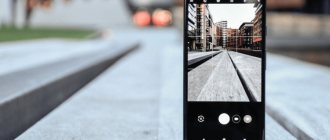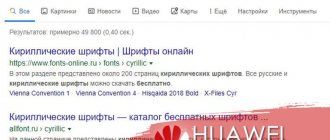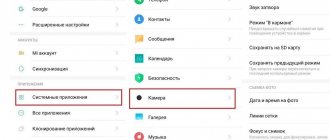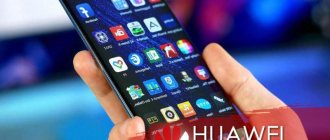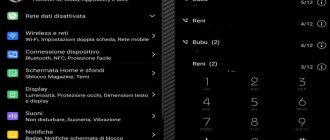Unlike the larger and more expensive P20 Pro smartphone, the standard Huawei P20 variant does without a triple camera, a large sensor and a telephoto lens. Instead, the device received a dual camera, which is similar to the cameras of previous flagship Huawei smartphones. The main 1/2.3-inch RGB sensor works with a 1/2.78-inch monochrome secondary chip. Data from them is combined to create bokeh effects, reduce digital noise, increase detail and dynamic range. The focal length of both modules is 27 mm, the aperture of the main one is f/1.8, the auxiliary one is f/1.6. The black and white module is especially useful for computer image processing.
The camera has the following characteristics:
- dual camera;
- the main camera shoots with a resolution of 12 MP, the RGB sensor has 1/2.3 inches, the lens has an aperture of f/1.8 and an equivalent focal length of 27 mm;
- the secondary camera has a 1/2.78-inch monochrome sensor shooting with a resolution of 20 MP, the lens has an f/1.6 aperture and an equivalent focal length of 27 mm;
- phase focusing;
- 5.8 "display, resolution 2240 x 1080;
- The default focal length is 55mm.
Shooting in bright light
In such conditions, the Huawei P20 camera gives no reason to complain. It is capable of capturing images with good textures and a wide dynamic range, with high detail in bright and dark areas. Some digital noise is noticeable when shooting blue skies, but it is generally under control. Precise white balance produces vibrant and pleasing images. Artifacts may be found, corners of images may be slightly blurred, ghosting may be visible, purple edges may appear on high contrast images, and sometimes there are background blur issues.
Tadaa SLR
There are fewer similar applications on iOS, but they are of good quality. For example, Tadaa SLR. In the program, you can quickly select the main subject, correct errors during selection, zoom in on part of the image and undo recent changes - this is the basic set necessary for successful photo editing. The application also allows you to change the intensity and type of blur, has a set of filters for additional post-processing, is easy to use and nicely designed. It is worth noting that the application is paid, its cost is approximately $5.
AppStore
Low-light photography and flash
The Huawei P20 takes a balanced approach to detail preservation and noise reduction in any lighting and ISO setting. The result is photos with good detail and low noise, even if the lighting leaves much to be desired. Autofocus doesn't slow down too much or lose accuracy in dark environments, which makes the device attractive for shooting at events, indoors, and other situations without good lighting.
Using a flash also allows you to take high-quality photographs. There is a decent level of exposure and detail in these photos, but red-eye is noticeable in many shots. There is a color shift at the edges of the frame both in complete darkness and in low light.
Zoom and Bokeh
The Huawei P20 does not have a telephoto lens, but an auxiliary monochrome sensor with high resolution and image processing is capable of producing a good two-fold magnification. If you want to enlarge the image even further, detail and overall quality quickly drop, with grain, artifacts, and pixelation appearing. Despite this, among smartphones without a telephoto lens, this device achieves the best result in image magnification.
Thanks to the monochrome sensor, which is also used to analyze depth of field, Huawei P20 gets natural results when blurring the background. Minor artifacts can be seen around the edges of objects, but object-background separation is generally very good. As a bonus, it can be noted that this mode works well not only in bright light, but also indoors (the photos below and below were taken on Huawei P20, Apple iPhone X and Google Pixel 2).
Huawei P20
Apple iPhone X
Google Pixel 2
How to enable and configure background blur in Huawei and Honor
First, let's look at what Bokeh is. This tool got its name in Japan, where the word meant “blur” or “haze.” In 2019, it is widely used in the world of professional and amateur photography, both on cameras and on mobile gadgets.
Let us immediately note that this option is provided in all Huawei and Honor smartphones, starting from Android 4.4, so there is no need to install it additionally. Photographers who use smartphones to capture images often draw attention to out-of-focus areas of their photos. This distinguishes their photographs from those taken using simple cameras or incorrectly configured gadgets. They are usually difficult to intentionally blur the background. The term "bokeh" describes the quality and characteristics of these in-focus areas. This mode most often appears in the form of spots of light.
The Boke area increases in images with a shallow depth of field and fairly large out-of-focus areas, and therefore depends on the size of the blurred areas of the image. Below are several ways to blur images on an Honor or Huawei smartphone, which adds a “Boke” effect to them.
"Portrait mode"
The simplest and most frequently used method. Takes a minute of your time:
- Open the camera;
- select “Portrait” mode;
- when activated, a camera symbol appears at the bottom left, open it;
- It is this section that is responsible for enabling background blur on your Huawei.
After these steps, the desired Boke mode is enabled. Then you can easily point the lens at a face or object and take a photo with a blurred background.
Aperture mode
The “Bokeh” effect on Honor and Huawei phones can also be launched through the aperture. To do this, open the camera and select the appropriate mode. Next, you will see the changes with the naked eye. In this section, the degree of background blur is adjusted as you need. To do this, tap on “Aperture Effect”. The higher this value, the more blurred the background behind will be.
Bokeh effect on existing images
If you have already taken a photo and want to add Boke to it, then Honor and Huawei will provide this opportunity.
- Go to the "Gallery".
- Open the desired frame.
- At the top, tap on the “Edit” tool.
- An adjustment panel will be located at the bottom.
- Select "Shading".
- Next, use the scale that appears to adjust the Boke concentration in the desired area.
Exposure and Contrast (92)
Huawei P20 achieves excellent exposure results. It is usually accurate in any light, and images come out with a wide dynamic range and high detail in dark and bright areas. The dynamic range outdoors is very wide.
There are no problems when working with the backlight. Subject exposure is very good, with high detail maintained even against a bright background. The iPhone X and Pixel 2 have much more noticeable limitations in this regard.
Huawei P20 can produce good exposure in 5 Lux lighting. Particularly in 1 Lux lighting, the photos are underexposed, but still acceptable.
1 suite
We meet by clothes
Getting to know a smartphone always starts with its appearance. The frame of Huawei Honor 9 Lite is made of aluminum, but the metal is felt only on the frame of the case. The front and back panels are glass, making the device look more expensive than its actual cost. The thickness is only 7.6 mm, the weight is 149 grams. The model will go on sale in three colors - black, gray and blue.
- The top-end Honor 20 Pro is officially presented in Russia
The width of the phone is less than 72 mm, that is, in terms of this indicator it is comparable to classic 5-inch devices. However, in the case of the ninth Honor Light, we are dealing with a diagonal of 5.65 inches. It is possible to increase the screen size without compromising the use of the device with one hand thanks to the 2:1 matrix proportions. The display resolution reaches 2160 × 1080 pixels, which means there is no pixelation visible to the naked eye.
Colors (84)
Colors in the P20's photos are bright and saturated most of the time, resulting in a well-deserved high rating. Color reproduction and automatic white balance are usually consistently correct. Only indoors there are occasional glimpses of orange, and even in bright light there are hints of purple in scenes with vegetation. Color shading is well controlled, with only occasional unevenness visible in some scenes. You have to look really hard to notice this.
As light levels decrease, color accuracy and white balance decrease.
Textures (75) and noise (75)
The score for textures and noise shows that the Chinese company's engineers have found an excellent balance between detail and noise suppression. As you can see in the example images, detail decreases with a slight drop in lighting. Overall, the device is able to maintain a good level of textures and control digital noise in very low light conditions. In bright light the detail is excellent.
Localized loss of low-contrast textures can sometimes be seen in low light, but overall noise reduction works well at all levels, with some graininess observed indoors and in low light.
When shooting portraits in low light, the device performs very well. Noise levels on skin are low and textures are excellent.
Artifacts (65)
Artifacts are under control, but there are areas where there is background blur, color ghosting and quite strong ghosting. Photos may be blurry in the corners, and there may be areas of the sky with reduced color saturation.
Images with fine textures also show blurriness in the corners. The problem is minor; it can only be noticed when the images are greatly enlarged.
Method No. 2 - blurred background through the “Aperture” mode
Launch the “Camera” application and select the “Aperture” mode. Look at the image below and see the difference:
The degree of background blur can be adjusted. To do this, click on the “Aperture Effect” icon (see screenshot below).
The larger the Aperture Effect value, the clearer the background will appear. Accordingly, for strong blur we set the minimum value.
Flash (81)
This rating shows a high quality flash, but not the best possible. When using the flash in complete darkness or low light at 5 Lux, exposure is good and noise levels are low. However, there is strong shading of colors around the edges of the frame. Red eye is noticeable in almost all photos of people, skin tones are too saturated and slightly pink. There is also a discrepancy in white balance between photographs one after another.
How to remove blur in photos of Honor and Huawei
If everything is clear with the addition of the effect, then a logical question arises - how to disable photo blur on Huawei and Honor? When using Aperture and Portrait Mode, simply disable these tools. The aperture is deactivated by an icon on the screen, and from the portrait lens you can quickly switch to the classic photo mode. If you manually applied blurry ones, you won’t be able to remove it.
If you have any questions or complaints, please let us know
If you applied Boke through Photoshop, by overlaying a layer, then it is possible to go into the project and simply remove this layer. But just in case, we recommend saving the original images on the cloud or in an archive.
Blurring the background in photographs is called the bokeh effect. Such photos are distinguished by a detailed foreground and blurry background. How to take a photo with a blurred background on Huawei and Honor smartphones? There are several working methods:
Zoom (51)
Unlike the Huawei P20 Pro, the standard variant of the smartphone does not have a telephoto lens. Instead, it uses a 20MP black and white sensor to achieve digital zoom, which is processed by software algorithms. Considering the lack of special optics, the results are quite impressive, at least at low zoom levels. Digital noise is kept under control.
With a higher magnification of the image, problems begin, as can be seen in the example images. The image becomes grainy and blurry. With telephoto lenses, the iPhone X clearly has an advantage in this regard. The Pixel 2 produces sharper images, but doesn't have the same maximum zoom as the Huawei P20, resulting in a wider viewing angle.
As a result, Huawei does an excellent job at close distances, especially in low light, and has an advantage in this regard over the iPhone X, despite its optical zoom. The comparison shows that the P20 takes sharper photos and better manages digital noise.
Bokeh effect (65)
With this assessment, Huawei P20 offers a very good simulation of the Bokeh effect. Testing was carried out in Aperture mode with a focal length of 55 mm, which is set by default. The separation of objects from the background is very good, and the light sources in the background have a clear shape. Among the disadvantages are blurring artifacts along the edges of the foreground object. There is also a difference in noise levels between objects in the frame in the background and in the foreground, resulting in an unnatural appearance when viewed closer. Overall, the camera is capable of excellent simulation of the bokeh effect.
The same can be said for indoor shooting: subject isolation is high, digital noise levels are low.
FabFocus
This program is primarily designed for editing portraits and has a built-in face detection algorithm. The application can work in automatic mode, independently finding the main object and blurring the background. If desired, the user can intervene in this process, select the shape for bokeh and the intensity of the effect. The program is simple to use and does not require any special training. But it requires money; purchasing FabFocus will cost the user about $5.
AppStore
That's all. You can tell us about your favorite photo editors in the comments.
Video rating
For video shooting, the device received 94 points, this is third place after Huawei P20 Pro and Google Pixel 2. This score is calculated based on a number of parameters when shooting moving objects: exposure (82), color (88), autofocus (96), textures (56 ), noise (71), artifacts (79) and stabilization (92).
One of the strengths of video shooting is excellent stabilization, which works effectively both on static objects and when the camera moves during recording. Just like when taking photos, autofocus does its job quickly and accurately, with consistent results. Exposure is trouble-free in all lighting conditions, and the auto white balance is accurate and produces nice, accurate colors outdoors and indoors. Detail is good in any lighting.
Among the disadvantages, there is luminance noise in relief areas during indoor recording under artificial lighting and low light. There may also be slight problems when adjusting exposure to changing light levels, and there is some loss of detail when shooting outdoors. Video under tungsten lamps may have an orange tint.
